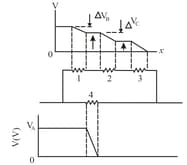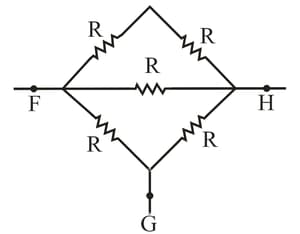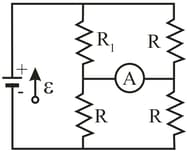Figure shows a circuit of four resistors that are connected to a larger circuit. The graph below the circuit shows the electric potential as a function of position along the lower branch of the circuit, through resistor the potential . The graph above the circuit shows the electric potential versus position along the upper branch of the circuit, through resistors and the potential differences are and Resistor has a resistance of and same potential drop as resistor What is the resistance of (a) resistor and (b) resistor ?



Important Questions on Circuits
(a) In electron-volts, how much work does an ideal battery with a emf do on an electron that passes through the battery from the positive to the negative terminal?
(b) If electrons pass through each second, what is the power of the battery in watts?
Figure shows five resistors. Calculate equivalent resistance between points (a) and and (b) and . (Hint: For each pair of points, imagine that a battery is connected across the pair.

In figure, the ideal batteries have emfs , and resistances are and . What are (a) the current (b) dissipation rate in resistor (c) dissipation rate in resistor and the energy transfer rate in (d) battery and (e) battery ? Is energy being supplied or absorbed by (f) battery and (g) battery ?

In fig., the ammeter resistance is zero and the battery is ideal. What multiple of gives the current in the ammeter?

